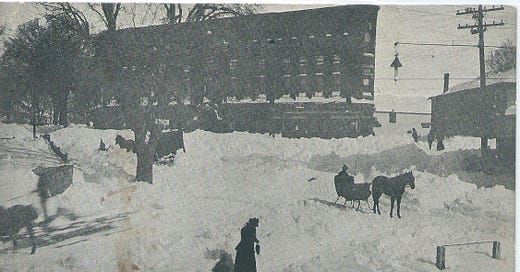Did you know the town faced one of its most severe storms in the winter of 1898?
The storm was a secondary cyclone, meaning it was part of a system with a larger primary cyclone. The system covered the entire northeast.
Snow began to fall in Andover early on Monday, January 31st. At night, snowfall intensified, gentle winds turned into gales, and temperatures dropped to as low as minus 14 degrees Fahrenheit. By Tuesday morning most progress in Andover slowed to a halt.
Two feet of snow covered the ground and wind built up to ten-foot thick drifts. Businesses and factories closed for the day and trains were exceptionally late if they managed to show up at all.

Andover citizens reported commute times of up to five hours from North Lawrence! Some had it even worse. Two Andover commuters slept overnight on a north-bound train in Somerville.
The snow tore down telephone and telegraph poles and strewed wires across the tracks. The wires were new, and railway workers refused to touch them. With broken lines, train dispatchers could no longer communicate.
It was, as the Townsman reported, a "grand mix up."
The storm was an annoyance to most commuters but to one a matter of life and death. Mrs. J. W. Tuttle fell to the ground on Park Street and could not get up amid heavy snowfall and strong wind. To her fortune, a neighbor spotted her and cared for her until the next morning.
To combat the storm, Andover residents took to their shovels.
Eventually, thin paths connected houses to streets and streets to downtown. A large crew under the direction of the town’s Street Commissioner carved a wide path along Main Street with snowplows. Improvised plows consisted of eight horses hitched to a sled that compacted snow beneath it.
The snowplows were effective on streets but could not clear sidewalks. Sidewalk clearing required the “intelligent use of shovels."
Residents on the outskirts of town opted to wait for plows to arrive later in the week. There was no sense in cutting miles-long footpaths.
The children of Andover had a much more relaxed experience than their parents. Snow meant play not work so they took full advantage of their days off from school.
By Thursday - four days after it started - the snow let up and many streets were clear. The morning temperature in Frye Village was 25 degrees below zero.
The storm cost the town thousands in damage and private citizens much more. The town spent $3,000 (~$94,000 in 2021) alone for snowplow services and employed over 100 men.
The Blizzard of 1898 was one of Andover’s most severe storms, but quick collective action by its citizens kept the town on the move.
Thank you to volunteer Floyd Greenwood for researching and writing this Miscellany Mondays article!





